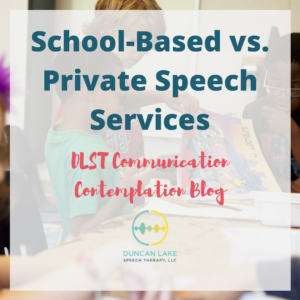A conversation that often comes up when I tell people I’m a speech-language pathologist often revolves around the topic of school-based speech and language services vs. private speech-language services. If you ask around, you’ll find that there are a lot of people out there who received speech services in school. In fact, according to the American Speech-Language-Hearing Association, Speech-Language Impairment is the 2nd highest eligibility for special education services in the United States. Over one million children receive speech services in the schools. Whoa, baby! This is why 56% of SLPs work in schools. There’s a lot of people to serve.
However, there are some key differences between school and private/medical-based services. Some folks might receive speech services in a private setting, but not be eligible for them in a school. Likewise, families may not want private services for various reasons.
As an SLP who worked and continues to work in the public schools while running a private speech practice, I thought I would take a moment to talk about these differences to help clarify each of their very important roles. Before I go into it, though, I want to say, for the record, that BOTH settings are EQUALLY important. The models are very different, but it doesn’t mean that one is better than the other. They provide different services for different reasons. SLPs, in a general sense, tend to be pretty type-A, hardworking people. Regardless of where your child gets services, their SLP rocks and is working hard to make sure your child gets the best speech therapy possible.

School-Based Services
- Qualifying: In short, school-based services function on an educational model. A child qualifies, or is eligible, for school-based speech-language services using an “academic impact” model. First, a child must meet the testing criteria for speech services. Each district has specific testing criteria for a child to qualify for speech services. For example, some districts require children be below a specific percentile ranking (like below the 9th percentile). If a child’s testing adequately qualifies them for services, we move to the next step – how does their speech impact their ability to perform in the general education classroom? This is where things get a little tricky.
Children can test on paper within district guidelines for speech-language services, but if the speech-language issue is not impacting their ability to perform in the classroom, they don’t qualify for services. We see this a lot with students who have an articulation disorder (like, let’s say, a lisp), but are straight-A students who participate readily in class. In this situation, the student wouldn’t qualify for services because they are not impacted academically by their articulation disorder.
- Service model: Students who receive school-based speech-language services are seen in a variety of ways and for a variety of times. School SLPs see students 1:1, in a group, or in the classroom (we call this last one a push-in model). Times and frequency are based on adequate service. In other words, how much does the SLP need to see the student in order to make adequate progress and to access the curriculum? The school-based model is not meant to be intensive. Additional programming, such as resource room time, can influence time/frequency. For instance, students who receive language support from the SLP and also receive language support from the resource teacher may not need to see the SLP as much as a student who doesn’t see the resource teacher for language support.
- Cost: Free, free, free!
Private or Medical-Based Services
- Qualifying: Private or medical-based services are based on a medical necessity model. In other words, is there an impact on this person’s life, and what is it? Are services medically necessary? If the answer is YES and it can be justified, services can be given. If the private/medical SLP is working with insurance, this justification will need to be crystal clear. Also, stay tuned for my blog post on insurance. The key difference here is that anytime there is a deficit, whether it be very severe or in the early stages, private practice SLPs can address it so long as there is a need that can be justified.
- Service model: Like in the schools, folks who receive private services can be seen in a variety of ways. However, the most common is 1:1. The intensity of service also varies. I see some kiddos on my caseload twice weekly for 30 minutes. Others, I see once weekly for an hour at a time. It’s not unusual, too, to see children multiple times weekly for 30-60 minutes. Private practice allows for more intensive services because, again, we’re not working on an educational model. We’re working on a medical necessity model.
- Cost: HIGHLY DEPENDENT ON THE CLINICIAN AND INSURANCE. Sessions can vary in cost from $0 via insurance to upwards of $300 a session. The cost of service depends greatly on the location of the practice, the experience of the clinician, and the reimbursement of insurance.
Each has their own pros and cons, but they’re both very important in providing needed services to the children! Comment with questions!


Awesome piece, thank you for sharing it very insightful.
I know how hard it is for anyone who need to deal with this and these info were very helpful